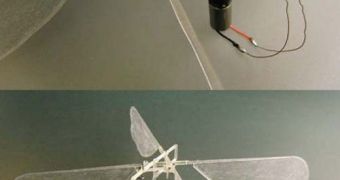Robotics experts at the Cornell University, in the United States, announce that they were recently able to create robotic ornithopters, using nothing by 3D printing technology. The devices are tiny, hovering, insect-like flying machines capable of altitude control.
The most difficult aspect of creating an artificial hovering insect is producing the wings. They need to be very flexible and lightweight, while at the same time strong enough to withstand rapid flapping and the deformations they endure while lifting their payload.
Ornithopters were until recently very hard to make because it took a very long time to construct the wings. The manufacturing process took up a lot of work hours and resources, and was very expensive.
But technological advancements are making wing production a much more accessible process. At this point, roboticians at Cornell can produce a complete set of wings in just a few minutes.
With the new prototyping technologies, it has now become possible to recreate the wing design of real insects. There is no longer a trial-and-error component in the manufacturing process, experts say.
The ornithopter produced at Cornell boasts wings that were produced through 3D printing. The entire apparatus weighs just 3.89 grams, and is capable of a flight autonomy of no less than 85 seconds.
With the help of an Objet EDEN260V 3D printer, robotics experts at the university were able to produce a carbon fiber frame for the wings, on which they stretched a thin, polythene film.
Other than the wings, the hovering robot also includes a fuselage containing a small GM14 motor, a crank and a wing hinge. A miniature gearbox was also included. Its purpose is to provide energy to a crankshaft that drives the wings.
The first flights this robot made were tethered, with power sent to it via a couple of wires. But the Cornell team soon realized that the wings generated enough lift to carry 1.5 grams of payload.
They say that this is exactly the mass of the batteries that were later used to make the ornithopter autonomous for 85 seconds. As soon as stand-alone flight tests began, the team attached two small sails above and below the hovering insect, in order to make its flight more stable.
In addition to applications in surveillance, the new robot could also be used to provide researchers with a fresh, new insight into the physics governing insect flight.
This is tremendous progress, considering that the first accurate replica of insect wings was created just 10 years ago. At the rate this field of research is progressing, we could expect to see such hovering robots in the sky within one or two decades, Wired reports.
Video Credit: Cornell University Computational Synthesis Laboratory

 14 DAY TRIAL //
14 DAY TRIAL //